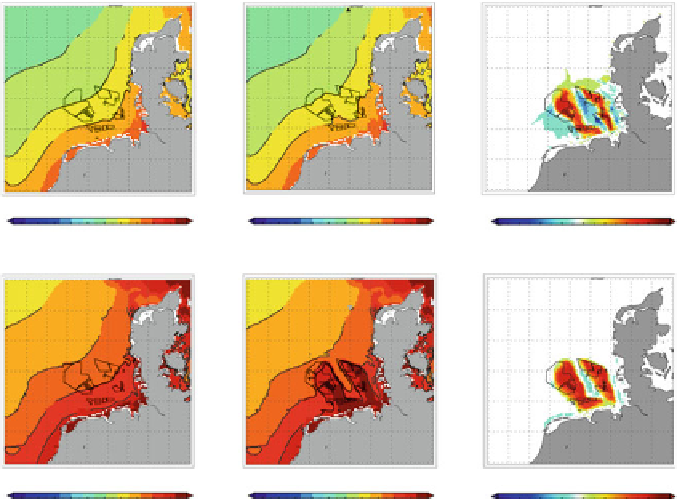Civil Engineering Reference
In-Depth Information
a1)
a2)
3
4567891
0
3
4
5
6
7
8
9
1
0
time(h): 24.00
max: 13.6640
min: 8.8197
time(h): 24.00
max: 13.6640
min: 8.8198
3
45678910
3
45678910
5.0
6.0
7.0
8.0 9.0 10.0 11.0 12.0 13.0 14.0 15.0
temperature (
°
C)
5.0
6.0
7.0
8.0 9.0 10.0 11.0 12.0 13.0 14.0 15.0
temperature (
°
C)
b1)
b2)
3
4
5
6
7
891
0
3
4
5
6
7
8
9
1
0
time(h): 24.00
max: 16.2192
min: 9.2446
time(h): 24.00
max: 16.2652
min: 9.2446
13
13
3
45678910
3
45678910
5.0
6.0
7.0
8.0 9.0 10.0 11.0 12.0 13.0 14.0 15.0
temperature (
°
C)
5.0
6.0
7.0
8.0 9.0 10.0 11.0 12.0 13.0 14.0 15.0
temperature (
°
C)
Fig. 6.16 SST within the German Bight for REFr (a1,b1) and OWFr (a2,b2) and differences
between OWFr and REFr (a3,b3).
Upper row
presents results for SST in case of wind and pressure
forcing;
second row
pictures SSTs in case of unrestrained forcing. Results show exemplary OWF
effect on SST for wind direction case N wind. OWF affects ocean flow, which leads to shift in
temperature front causing warming/cooling at surface compared to reference run
forcing only and full meteorological forcing after 1 day. The differences between
runs OWFr and REFr in SST rely on a deformation of the temperature front, visible
at the 9 and 10
C contour line, which is deformed by the velocity wake. The shift in
the case of full forcing is superposed by the impact on the temperature forcing on
SST.
While dynamics only end in a temperature effect, due to the OWF by
0.20
C,
the full meteorological forcing leads to an average SST warming of 1.68
C and a
cooling of 0.72
C. Considering the full forcing and the OWF induced warming at
10-m heights, the SST and the upper ocean are significantly warmer than in the case
of wind and pressure forcing only. A wind and pressure forcing only represents only
12-29 % of the OWF effect on ocean temperature related to simulation results
under full forcing. But considering now that under more realistic meteorological
conditions the atmosphere will cool, as mentioned before, and bearing in mind that
simulations show dominantly an upwelling in the OWF district, it must be expected
that the German Bight would suffer an overall cooling.














































































































































































Search WWH ::

Custom Search